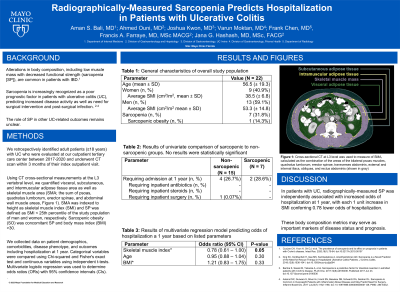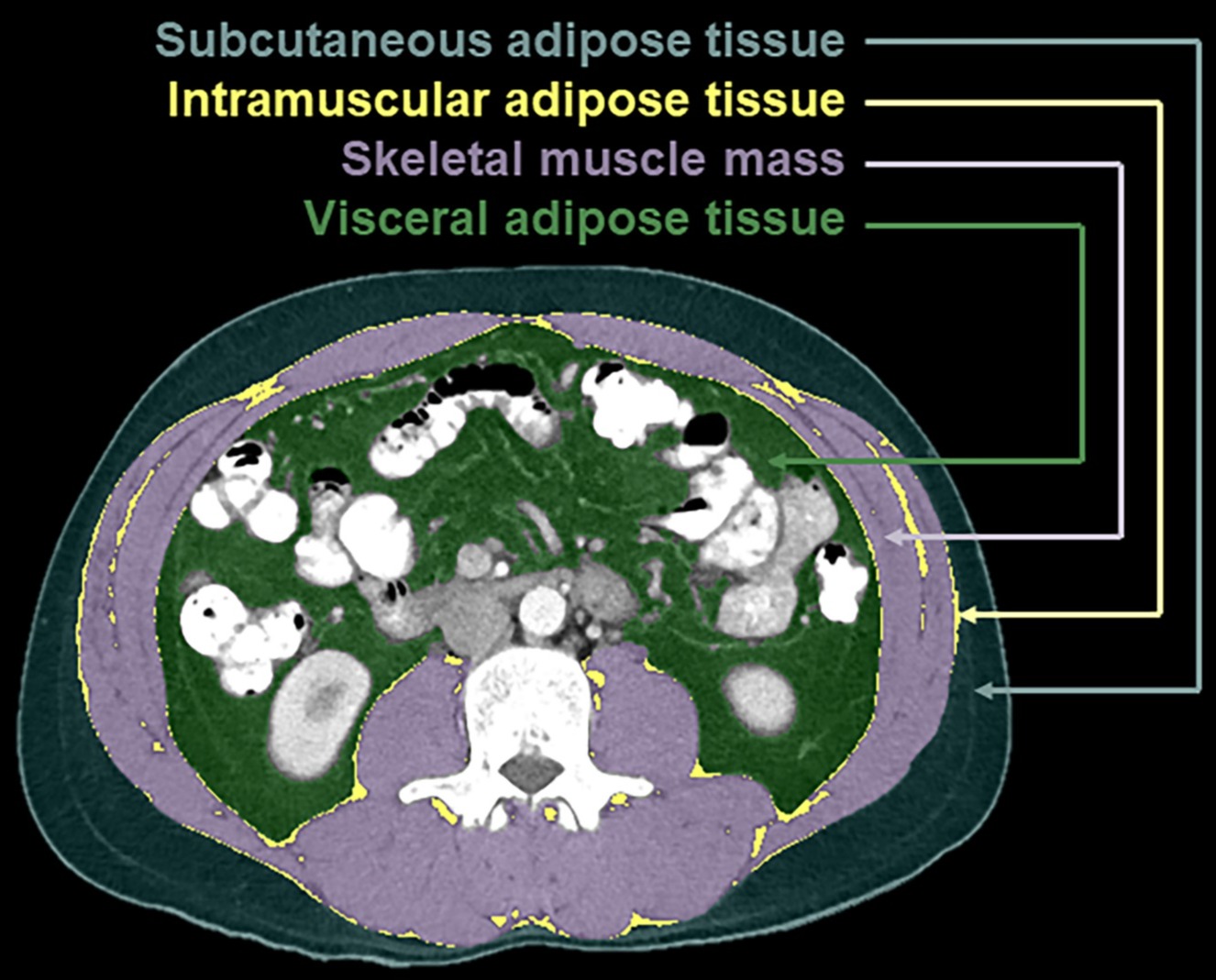Monday Poster Session
Category: IBD
P2189 - Radiographically-Measured Sarcopenia Predicts Hospitalization in Patients with Ulcerative Colitis
Monday, October 23, 2023
10:30 AM - 4:15 PM PT
Location: Exhibit Hall

Has Audio

Aman Bali, MD
Mayo Clinic Florida
Jacksonville, FL
Presenting Author(s)
Aman Bali, MD1, Ahmed Ouni, MD2, Kwon Joshua, MD3, Varun Moktan, MD4, Chen Frank, MD1, Francis A. Farraye, MD, MSc, MACG2, Jana G.. Hashash, MD, MSc, FACG2
1Mayo Clinic Florida, Jacksonville, FL; 2Mayo Clinic, Jacksonville, FL; 3University of California Irvine, Orange, CA; 4Prisma Health-Upstate, Greenville, SC
Introduction: Sarcopenia (SP) is a measure of body composition defined as low lean muscle mass with decreased functional strength. It is increasingly recognized as a poor prognostic factor in patients with ulcerative colitis (UC), predicting increased disease activity as well as need for surgical intervention and post-surgical infection. However, its role in other UC-related outcomes remains underinvestigated.
Methods: We retrospectively identified adult patients (≥18 years) with UC who were evaluated at our outpatient tertiary care center between 2017-2020 and underwent CT scan within 3 months of their visit. Using CT cross-sectional measurements at the L3 vertebral level, we quantified visceral, subcutaneous, and intermuscular adipose tissue area as well as skeletal muscle area (SMA; the sum of psoas, quadratus lumborum, erector spinae, and abdominal wall muscle areas, Figure). SMA was indexed to height as skeletal muscle index (SMI) and SP was defined as SMI < 25th percentile of the study population of men and women. Sarcopenic obesity (SO) was concomitant SP and body mass index (BMI) >30. We collected data on patient demographics, comorbidities, disease phenotype, and outcomes including hospitalization at 1 year. Categorical variables were compared using Chi-squared and Fisher's exact test and continuous variables using independent t-tests. Multivariate logistic regression was used to determine odds ratios (ORs) with 95% confidence intervals (CIs).
Results: Twenty-two patients with UC were included with mean age of 56.5 years ±19.3. Overall 40.9% (9/22) of patients were women with average SMI of 38.5±6.8 cm2/m2 vs 53.3±14.8 for men. A third, 31.8% (7/22), of patients had SP and of these 14.3% (1/7) had SO. In univarate analysis comparing patients with normal body composition to those with SP alone and SO, no statiscally significant differences were observed in rates of UC-related outcomes including hospitalization at 1 year or receiving inpatient antibiotics or steroids. On multivariate regression, lower SMI was associated with increased odds of hospitalization at 1 year, with each 1 unit increase in SMI conferring 0.78 lower odds of hospitalization (OR 0.78 [95%CI 0.61-1.00], p=0.05).
Discussion: In patients with UC, radiographically-measured SP was associated with increased odds of hospitalization at 1 year. Body composition metrics may serve as important markers of disease status and prognosis.

Disclosures:
Aman Bali, MD1, Ahmed Ouni, MD2, Kwon Joshua, MD3, Varun Moktan, MD4, Chen Frank, MD1, Francis A. Farraye, MD, MSc, MACG2, Jana G.. Hashash, MD, MSc, FACG2. P2189 - Radiographically-Measured Sarcopenia Predicts Hospitalization in Patients with Ulcerative Colitis, ACG 2023 Annual Scientific Meeting Abstracts. Vancouver, BC, Canada: American College of Gastroenterology.
1Mayo Clinic Florida, Jacksonville, FL; 2Mayo Clinic, Jacksonville, FL; 3University of California Irvine, Orange, CA; 4Prisma Health-Upstate, Greenville, SC
Introduction: Sarcopenia (SP) is a measure of body composition defined as low lean muscle mass with decreased functional strength. It is increasingly recognized as a poor prognostic factor in patients with ulcerative colitis (UC), predicting increased disease activity as well as need for surgical intervention and post-surgical infection. However, its role in other UC-related outcomes remains underinvestigated.
Methods: We retrospectively identified adult patients (≥18 years) with UC who were evaluated at our outpatient tertiary care center between 2017-2020 and underwent CT scan within 3 months of their visit. Using CT cross-sectional measurements at the L3 vertebral level, we quantified visceral, subcutaneous, and intermuscular adipose tissue area as well as skeletal muscle area (SMA; the sum of psoas, quadratus lumborum, erector spinae, and abdominal wall muscle areas, Figure). SMA was indexed to height as skeletal muscle index (SMI) and SP was defined as SMI < 25th percentile of the study population of men and women. Sarcopenic obesity (SO) was concomitant SP and body mass index (BMI) >30. We collected data on patient demographics, comorbidities, disease phenotype, and outcomes including hospitalization at 1 year. Categorical variables were compared using Chi-squared and Fisher's exact test and continuous variables using independent t-tests. Multivariate logistic regression was used to determine odds ratios (ORs) with 95% confidence intervals (CIs).
Results: Twenty-two patients with UC were included with mean age of 56.5 years ±19.3. Overall 40.9% (9/22) of patients were women with average SMI of 38.5±6.8 cm2/m2 vs 53.3±14.8 for men. A third, 31.8% (7/22), of patients had SP and of these 14.3% (1/7) had SO. In univarate analysis comparing patients with normal body composition to those with SP alone and SO, no statiscally significant differences were observed in rates of UC-related outcomes including hospitalization at 1 year or receiving inpatient antibiotics or steroids. On multivariate regression, lower SMI was associated with increased odds of hospitalization at 1 year, with each 1 unit increase in SMI conferring 0.78 lower odds of hospitalization (OR 0.78 [95%CI 0.61-1.00], p=0.05).
Discussion: In patients with UC, radiographically-measured SP was associated with increased odds of hospitalization at 1 year. Body composition metrics may serve as important markers of disease status and prognosis.

Figure: Visualization of CT image segmentation at L3 vertebral level used to perform quantification of body composition
Disclosures:
Aman Bali indicated no relevant financial relationships.
Ahmed Ouni indicated no relevant financial relationships.
Kwon Joshua indicated no relevant financial relationships.
Varun Moktan indicated no relevant financial relationships.
Chen Frank indicated no relevant financial relationships.
Francis Farraye: AbbVie – Advisory Committee/Board Member. Avalo Therapeutics – Advisory Committee/Board Member. BMS – Advisory Committee/Board Member. Braintree Labs – Advisory Committee/Board Member. Fresenius Kabi – Advisory Committee/Board Member. GI Reviewers – Independent Contractor. GSK – Advisory Committee/Board Member. IBD Educational Group – Independent Contractor. Iterative Health – Advisory Committee/Board Member. Janssen – Advisory Committee/Board Member. Pfizer – Advisory Committee/Board Member. Pharmacosmos – Advisory Committee/Board Member. Sandoz Immunology – Advisory Committee/Board Member. Sebela – Advisory Committee/Board Member. Viatris – Advisory Committee/Board Member.
Jana Hashash: Iterative Health – Grant/Research Support.
Aman Bali, MD1, Ahmed Ouni, MD2, Kwon Joshua, MD3, Varun Moktan, MD4, Chen Frank, MD1, Francis A. Farraye, MD, MSc, MACG2, Jana G.. Hashash, MD, MSc, FACG2. P2189 - Radiographically-Measured Sarcopenia Predicts Hospitalization in Patients with Ulcerative Colitis, ACG 2023 Annual Scientific Meeting Abstracts. Vancouver, BC, Canada: American College of Gastroenterology.
